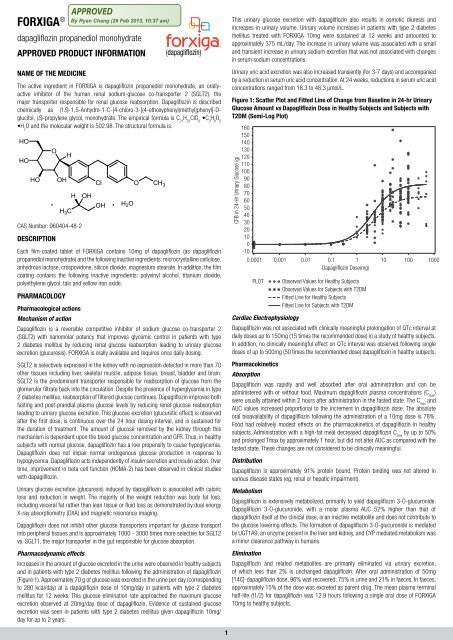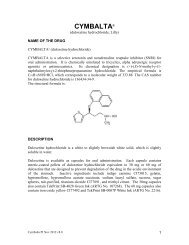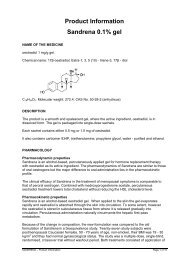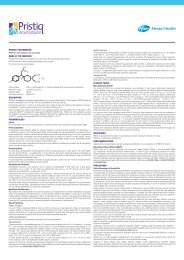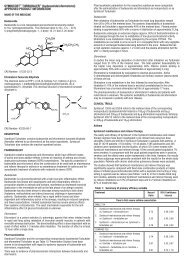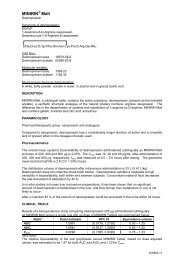Create successful ePaper yourself
Turn your PDF publications into a flip-book with our unique Google optimized e-Paper software.
FORXIGA ®dapagliflozin propanediol monohydrateAPPROVED PRODUCT INFORMATIONNAME OF THE MEDICINEThe active ingredient in FORXIGA is dapagliflozin propanediol monohydrate, an orallyactiveinhibitor of the human renal sodium-glucose co-transporter 2 (SGLT2), themajor transporter responsible for renal glucose reabsorption. Dapagliflozin is describedchemically as (1S)-1,5-Anhydro-1-C-[4-chloro-3-[(4-ethoxyphenyl)methyl]phenyl]-Dglucitol,(S)-propylene glycol, monohydrate. The empirical formula is C 21H 25ClO 6•C 3H 8O 2•H 2O and the molecular weight is 502.98. The structural formula is:HOHOHOOOHHH 3 CHCAS Number: 960404-48-2DESCRIPTIONOHCl O CH 3. . H 2 OOHEach film-coated tablet of FORXIGA contains 10mg of dapagliflozin (as dapagliflozinpropanediol monohydrate) and the following inactive ingredients: microcrystalline cellulose,anhydrous lactose, crospovidone, silicon dioxide, magnesium stearate. In addition, the filmcoating contains the following inactive ingredients: polyvinyl alcohol, titanium dioxide,polyethylene glycol, talc and yellow iron oxide.PHARMACOLOGYPharmacological actionsMechanism of actionDapagliflozin is a reversible competitive inhibitor of sodium glucose co-transporter 2(SGLT2) with nanomolar potency that improves glycemic control in patients with type2 diabetes mellitus by reducing renal glucose reabsorption leading to urinary glucoseexcretion (glucuresis). FORXIGA is orally available and requires once daily dosing.SGLT2 is selectively expressed in the kidney with no expression detected in more than 70other tissues including liver, skeletal muscle, adipose tissue, breast, bladder and brain.SGLT2 is the predominant transporter responsible for reabsorption of glucose from theglomerular filtrate back into the circulation. Despite the presence of hyperglycemia in type2 diabetes mellitus, reabsorption of filtered glucose continues. Dapagliflozin improves bothfasting and post-prandial plasma glucose levels by reducing renal glucose reabsorptionleading to urinary glucose excretion. This glucose excretion (glucuretic effect) is observedafter the first dose, is continuous over the 24 hour dosing interval, and is sustained forthe duration of treatment. The amount of glucose removed by the kidney through thismechanism is dependent upon the blood glucose concentration and GFR. Thus, in healthysubjects with normal glucose, dapagliflozin has a low propensity to cause hypoglycemia.Dapagliflozin does not impair normal endogenous glucose production in response tohypoglycemia. Dapagliflozin acts independently of insulin secretion and insulin action. Overtime, improvement in beta cell function (HOMA-2) has been observed in clinical studieswith dapagliflozin.Urinary glucose excretion (glucuresis) induced by dapagliflozin is associated with caloricloss and reduction in weight. The majority of the weight reduction was body fat loss,including visceral fat rather than lean tissue or fluid loss as demonstrated by dual energyX-ray absorptiometry (DXA) and magnetic resonance imaging.Dapagliflozin does not inhibit other glucose transporters important for glucose transportinto peripheral tissues and is approximately 1000 - 3000 times more selective for SGLT2vs. SGLT1, the major transporter in the gut responsible for glucose absorption.Pharmacodynamic effectsIncreases in the amount of glucose excreted in the urine were observed in healthy subjectsand in patients with type 2 diabetes mellitus following the administration of dapagliflozin(Figure 1). Approximately 70 g of glucose was excreted in the urine per day (correspondingto 280 kcal/day) at a dapagliflozin dose of 10mg/day in patients with type 2 diabetesmellitus for 12 weeks. This glucose elimination rate approached the maximum glucoseexcretion observed at 20mg/day dose of dapagliflozin. Evidence of sustained glucoseexcretion was seen in patients with type 2 diabetes mellitus given dapagliflozin 10mg/day for up to 2 years.This urinary glucose excretion with dapagliflozin also results in osmotic diuresis andincreases in urinary volume. Urinary volume increases in patients with type 2 diabetesmellitus treated with FORXIGA 10mg were sustained at 12 weeks and amounted toapproximately 375 mL/day. The increase in urinary volume was associated with a smalland transient increase in urinary sodium excretion that was not associated with changesin serum sodium concentrations.Urinary uric acid excretion was also increased transiently (for 3-7 days) and accompaniedby a reduction in serum uric acid concentration. At 24 weeks, reductions in serum uric acidconcentrations ranged from 18.3 to 48.3 μmol/L.Figure 1: Scatter Plot and Fitted Line of Change from Baseline in 24‐hr UrinaryGlucose Amount vs Dapagliflozin Dose in Healthy Subjects and Subjects withT2DM (Semi-Log Plot)CFB in 24-Hr Urinary Glucose (g)1601501401301201101009080706050403020100-100.0001 0.001 0.01 0.1 1 10 100 1000Dapagliflozin Dose(mg)PLOTObserved Values for Healthy SubjectsObserved Values for Subjects with T2DMFitted Line for Healthy SubjectsFitted Line for Subjects with T2DMCardiac ElectrophysiologyDapagliflozin was not associated with clinically meaningful prolongation of QTc interval atdaily doses up to 150mg (15 times the recommended dose) in a study of healthy subjects.In addition, no clinically meaningful effect on QTc interval was observed following singledoses of up to 500mg (50 times the recommended dose) dapagliflozin in healthy subjects.PharmacokineticsAbsorptionDapagliflozin was rapidly and well absorbed after oral administration and can beadministered with or without food. Maximum dapagliflozin plasma concentrations (C max)were usually attained within 2 hours after administration in the fasted state. The C maxandAUC values increased proportional to the increment in dapagliflozin dose. The absoluteoral bioavailability of dapagliflozin following the administration of a 10mg dose is 78%.Food had relatively modest effects on the pharmacokinetics of dapagliflozin in healthysubjects. Administration with a high-fat meal decreased dapagliflozin C maxby up to 50%and prolonged Tmax by approximately 1 hour, but did not alter AUC as compared with thefasted state. These changes are not considered to be clinically meaningful.DistributionDapagliflozin is approximately 91% protein bound. Protein binding was not altered invarious disease states (eg, renal or hepatic impairment).MetabolismDapagliflozin is extensively metabolized, primarily to yield dapagliflozin 3-O-glucuronide.Dapagliflozin 3-O-glucuronide, with a molar plasma AUC 52% higher than that ofdapagliflozin itself at the clinical dose, is an inactive metabolite and does not contribute tothe glucose lowering effects. The formation of dapagliflozin 3-O-glucuronide is mediatedby UGT1A9, an enzyme present in the liver and kidney, and CYP mediated metabolism wasa minor clearance pathway in humans.EliminationDapagliflozin and related metabolites are primarily eliminated via urinary excretion,of which less than 2% is unchanged dapagliflozin. After oral administration of 50mg[14C]‐dapagliflozin dose, 96% was recovered, 75% in urine and 21% in faeces. In faeces,approximately 15% of the dose was excreted as parent drug. The mean plasma terminalhalf-life (t1/2) for dapagliflozin was 12.9 hours following a single oral dose of FORXIGA10mg to healthy subjects.1
Special PopulationsNo dosages adjustments based on pharmacokinetic analyses are recommended fornormal‐to‐mild renal impairment (eGFR ≥ 60 mL/min/1.73 m 2 or CrCl ≥ 60 mL/min), mild,or moderate hepatic impairment, age, gender, race and body weight.Renal ImpairmentFor dosing recommendations for patients with mild renal impairment see DOSAGE andADMINISTRATION). At steady-state (20mg once-daily dapagliflozin for 7 days), patients withtype 2 diabetes and mild, moderate or severe renal impairment (as determined by iohexolclearance) had mean systemic exposures of dapagliflozin that were 32%, 60% and 87%higher, respectively, than those of patients with type 2 diabetes and normal renal function.At dapagliflozin 20mg once-daily, higher systemic exposure to dapagliflozin in patients withtype 2 diabetes mellitus and renal impairment did not result in a correspondingly higherrenal glucose clearance or 24 hour glucose excretion. The renal glucose clearance and 24hour glucose excretion was lower in patients with moderate or severe renal impairmentas compared to patients with normal and mild renal impairment. The steady-state 24-hurinary glucose excretion was highly dependent on renal function and 85, 52, 18 and11g of glucose/day was excreted by patients with type 2 diabetes mellitus and normalrenal function or mild, moderate or severe renal impairment, respectively. There were nodifferences in the protein binding of dapagliflozin between renal impairment groups orcompared to healthy subjects. The impact of hemodialysis on dapagliflozin exposure isnot known.Hepatic ImpairmentFor dosing recommendations for patients with moderate hepatic impairment (see DOSAGEand ADMINISTRATION). A single dose (10mg) dapagliflozin clinical pharmacology studywas conducted in patients with mild, moderate or severe hepatic impairment (Child-Pughclasses A, B, and C, respectively) and healthy matched controls in order to compare thepharmacokinetic characteristics of dapagliflozin between these populations. There were nodifferences in the protein binding of dapagliflozin between hepatic impairment groups orcompared to healthy subjects. In patients with mild or moderate hepatic impairment meanC maxand AUC of dapagliflozin were up to 12% and 36% higher, respectively, compared tohealthy matched control subjects. These differences were not considered to be clinicallymeaningful and no dose adjustment from the proposed usual dose of 10mg once daily fordapagliflozin is proposed for these populations. In patients with severe hepatic impairment(Child-Pugh class C) mean C maxand AUC of dapagliflozin were up to 40% and 67% higherthan matched healthy controls, respectively.AgeNo dosage adjustment for dapagliflozin is recommended on the basis of age. The effectof age (young: ≥18 to 70 years old.Paediatric and AdolescentPharmacokinetics in the paediatric and adolescent population have not been studied.GenderNo dosage adjustment from the dose of 10mg once daily is recommended fordapagliflozin on the basis of gender. Gender was evaluated as a covariate in a populationpharmacokinetic model using data from healthy subject and patient studies. The meandapagliflozin AUCss in females (n=619) was estimated to be 22% higher than in males(n=634) [90% CI: 117,124].RaceNo dosage adjustment from the dapagliflozin dose of 10mg once daily is recommendedon the basis of race. Race (white, black [African descent] or Asian) was evaluated as acovariate in a population pharmacokinetic model using data from healthy subject andpatient studies. Differences in systemic exposures between these races were small.Compared to whites (n=1147), Asian subjects (n=47) had no difference in estimatedmean dapagliflozin systemic exposures [90% CI range 3.7% lower, 1% higher]. Comparedto whites, black (African descent) subjects (n=43) had 4.9% lower estimated meandapagliflozin systemic exposures [90% CI range 7.7% lower, 3.7% lower].Body WeightNo dose adjustment is recommended on the basis of weight.In a population pharmacokinetic analysis using data from healthy subject and patientstudies, systemic exposures in high body weight subjects (≥120 kg, n=91) were estimatedto be 78.3% [90% CI: 78.2, 83.2%] of those of reference subjects with body weightbetween 75 and 100 kg. This difference is considered to be small, therefore, no doseadjustment from the proposed dose of 10mg dapagliflozin once daily in type 2 diabetesmellitus patients with high body weight (≥120 kg) is recommended.Subjects with low body weights (
Table 1: Results at Week 24 (LOCF*) in a Placebo-Controlled Studyof FORXIGA Monotherapy in Patients with Type 2 Diabetes(Main Cohort AM Doses)Efficacy ParameterHbA1c (%)FORXIGA 10mg PlaceboN=70 † N=75 †Baseline (mean) 8.01 7.79Change from baseline (adjusted mean ‡ ) −0.89 −0.23Difference from placebo (adjusted mean ‡ )(95% CI)Percent of patients achieving HbA1c 7.5%; after week 76 to week 102 (excluding week 102): HbA1c >7%.Combination TherapyFORXIGA was studied as add-on to metformin, add-on to a sulfonylurea (glimepiride), andadd-on to insulin (with or without other antidiabetic therapies).Combination Therapy with MetforminFour studies were conducted in combination with metformin therapy: two studies evaluatedFORXIGA added to metformin as initial combination therapy, one study evaluated the effectof FORXIGA added to metformin in patients already on metformin, and one study evaluatedthe effect of FORXIGA added to metformin vs. sulfonylurea.Initial Combination Therapy with MetforminA total of 1,244 treatment-naive patients with inadequately controlled type 2 diabetes(HbA1c ≥7.5% and ≤12%) participated in two active-controlled studies of 24-weeksduration to evaluate the efficacy and safety of initial therapy with dapagliflozin 5mg orFORXIGA 10mg in combination with metformin extended-release formulation (XR). In bothstudies, treatment-naive patients were defined as either never having received diabetesmedication or having had such for less than 24 weeks since the diagnosis of diabetes, notfor more than 14 days during the 12 weeks prior to enrolment, and not at all during the 4weeks prior to enrolment.In one study, 641 patients were randomized to one of three treatment arms followinga 1-week lead-in period: FORXIGA 10mg plus metformin XR (up to 2000mg per day),FORXIGA 10mg plus placebo, or metformin XR (up to 2000mg per day) plus placebo.Metformin dose was up-titrated weekly in 500mg increments, as tolerated, with themaximum and median dose achieved being 2000mg.The combination treatment of FORXIGA 10mg plus metformin provided significantimprovements in HbA1c and FPG, compared with either of the monotherapy treatmentsand significant improvements in body weight compared with metformin alone. (Table 2,Figures 3 and 4). FORXIGA 10mg as monotherapy also provided significant improvementsin FPG and body weight compared with metformin alone and was non-inferior tometformin monotherapy in lowering HbA1c. The proportion of patients who were rescuedor discontinued for lack of glycemic control during the 24 week double-blind treatmentperiod (adjusted for baseline HbA1c) was higher on treatment with metformin plus placebo(13.5%) than on FORXIGA 10mg plus placebo and FORXIGA 10mg plus metformin (7.8%,and 1.4%).Table 2: Results at Week 24 (LOCF*) in an Active-Controlled Study ofFORXIGA Initial Combination Therapy with Metformin XRHbA1c (%) Adjusted Mean Change from Baseline0.0-0.5-1.0Efficacy ParameterHbA1c (%)FORXIGA 10mg FORXIGA 10mg MetforminN=211 † N=208 †+ Metformin XR N=219 † XRBaseline (mean) 9.10 9.03 9.03Change from baseline(adjusted mean ‡ )Difference from FORXIGA(adjusted mean ‡ ) (95% CI)Difference from metformin(adjusted mean ‡ ) (95% CI)−1.98 −1.45 −1.44−0.53 §(−0.74, −0.32)−0.54 §(−0.75, −0.33)−0.01 (−0.22, 0.20)0 4 8 12 16 20 24Study Week(N=75) PLA(N=65) DAPA 2.5 MG QAM(N=65) DAPA 5 MG QAM(N=70) DAPA 10 MG QAMError bars represent 95% confidence intervals for the adjusted mean change from baselinePercent of patients achievingHbA1c
Table 2: Results at Week 24 (LOCF*) in an Active-Controlled Study ofFORXIGA Initial Combination Therapy with Metformin XREfficacy ParameterFORXIGA 10mg FORXIGA 10mg MetforminN=211 † N=208 †+ Metformin XR N=219 † XRFigure 4: Adjusted Mean Change from Baseline Over Time (LOCF a ) in TotalBody Weight (kg) in a 24‐Week Active-Controlled Study of FORXIGA InitialCombination Therapy with Metformin XR0Change from baseline(adjusted mean ‡ )Difference from FORXIGA(adjusted mean ‡ ) (95% CI)Difference from metformin(adjusted mean ‡ ) (95% CI)Body Weight (kg)−3.4 −2.6 −1.9−0.8 §(−1.2, −0.4)−1.4 §(−1.8, −1.0)−0.6 (−1.0, −0.3)Baseline (mean) 88.56 88.53 87.24Change from baseline(adjusted mean ‡ )−3.33 −2.73 −1.36Total Body Weight (kg)Adjusted Mean Change from Baseline-1-2-3Difference from metformin(adjusted mean ‡ ) (95% CI)−1.97 §(−2.64, −1.30)−1.37 §(−2.03, −0.71)* LOCF: last observation (prior to rescue for rescued patients) carried forward.†All randomized patients who took at least one dose of double-blind study medication during theshort-term double-blind period.‡Least squares mean adjusted for baseline value.§p-value
Table 3: Results of a 24-Week (LOCF*) Placebo-Controlled Study of FORXIGAin Add-On Combination with MetforminEfficacy ParameterFPG (mmol/L)PlaceboFORXIGA 10mgN=135 † N=137 †+ Metformin + MetforminBaseline mean 8.7 9.2Change from baseline at week 24(adjusted mean ‡ )Difference from placebo (adjusted mean ‡ )(95% CI)Change from baseline at week 1(adjusted mean ‡ )Body Weight (kg)−1.3 −0.3−1.0 §(−1.4, −0.6)−0.9 §(N=115)0.1(N=126)Baseline mean 86.28 87.74Change from baseline (adjusted mean ‡ ) −2.86 −0.89Difference from placebo (adjusted mean ‡ )(95% CI)−1.97 §(−2.63, −1.31)* LOCF: last observation (prior to rescue for rescued patients) carried forward.†All randomized patients who took at least one dose of double-blind study medication during theshort-term double-blind period.‡Least squares mean adjusted for baseline value.§p-value
Figure 7: Adjusted mean change from baseline over time in Body Weight (LOCF)for the 52-week short-term treatment period in an Active-Controlled Studycomparing FORXIGA to Glipizide as Add-on to MetforminTable 5: Results of 24-Week (LOCF*) Placebo-Controlled Study of FORXIGAin Combination with Sulfonylurea (Glimepiride)2Efficacy Parameter FORXIGA 10mg +glimepiridePlacebo +glimepirideTotal Body Weight (kg)Adjusted Mean Change from Baseline10-1-2-3-40 6 12 18 26 34 42 52Study WeekTreatment Group( N= 400 ) DAPA + MET( N= 401 ) GLIP + METError bars represent 95% confidence intervals for the adjusted mean change from baselineCombination therapy with Other Anti-Diabetic AgentsAdd-on Combination Therapy with a SulfonylureaA total of 597 patients with type 2 diabetes and inadequate glycemic control (HbA1c ≥7%and ≤10%) were randomized in this 24-week, placebo-controlled study with a 24-weekextension period to evaluate FORXIGA in combination with glimepiride (a sulfonylurea).Patients on at least half the maximum recommended dose of glimepiride as monotherapy(4mg) for at least 8 weeks lead-in were randomized to dapagliflozin 2.5mg, dapagliflozin5 mg, or FORXIGA 10mg or placebo in addition to glimepiride 4mg per day. Down-titrationof glimepiride to 2mg or 0mg was allowed for hypoglycemia during the treatment period;no up-titration of glimepiride was allowed.In combination with glimepiride, FORXIGA 10mg provided significant improvement inHbA1c, FPG, 2-hour PPG, and body weight compared with placebo plus glimepiride atweek 24 (Table 5, Figure 8). At week 48, adjusted mean change from baseline in HbA1c,FPG, and body weight were -0.73%, -1.6 mmol/L, and -2.41 kg, respectively, for patientstreated with FORXIGA 10mg plus glimepiride and -0.04%, 0.1 mmol/L, and -0.77 kgfor patients treated with placebo plus glimepiride at week 48 based on the longitudinalrepeated measures analysis excluding data after rescue.The proportion of patients who were rescued or discontinued for lack of glycemiccontrol (adjusted for baseline HbA1c) was higher on placebo plus glimepiride (16.2%)than on FORXIGA 10mg plus glimepiride (2.0%). By week 48, more patients on placeboplus glimepiride (53.1%) required rescue therapy than patients on FORXIGA 10mg plusglimepiride (17.9%).Table 5: Results of 24-Week (LOCF*) Placebo-Controlled Study of FORXIGAin Combination with Sulfonylurea (Glimepiride)Efficacy Parameter FORXIGA 10mg +glimepiridePlacebo +glimepirideIntent-to-Treat Population N=151 † N=145 †HbA1c (%)Baseline (mean) 8.07 8.15Change from baseline (adjusted mean ‡ ) −0.82 −0.13Difference from placebo + glimepiride(adjusted mean ‡ )(95% CI)Percent of patients achieving HbA1c
In this study, 50% of patients were on insulin monotherapy at baseline, while 50% were on1 or 2 OADs in addition to insulin, mostly metformin alone (40%) and a smaller percentageusing metformin plus a sulphonylurea (5.8%) or other combinations (4.4%). The medianinsulin dose was 65 units daily with 20% of subjects on > 100 units daily. At week 24,FORXIGA 10mg dose provided significant improvement in HbA1c, body weight, and meaninsulin dose compared with placebo in combination with insulin, with or without up to 2OADs (Table 7, Figures 10,11 and 12); the effect of FORXIGA on HbA1c was similar inpatients on insulin alone and patients on insulin plus OAD. At week 48, adjusted meanchange from baseline in HbA1c, FPG, and body weight was -0.93%, -1.2 mmol/L, and-1.79 kg, respectively, for patients treated with FORXIGA 10mg plus insulin and -0.43%,-0.2 mmol/L, and -0.18 kg, respectively, for patients treated with placebo at week 48based on the longitudinal repeated measures analysis excluding data after rescue.At week 24, a significantly higher proportion of patients on FORXIGA 10mg could reduce theinsulin dose by at least 10% compared to placebo. The proportion of patients who requiredup-titration of their insulin dose or discontinued due to lack of glycemic control (adjustedfor baseline HbA1c) was higher on placebo plus insulin (29.2%) than on FORXIGA 10mgplus insulin (9.7%). The insulin dose remained stable in patients treated with FORXIGA, butcontinued to increase (mean increase 10.5 IU from baseline) in placebo-treated patientsup to 48 weeks. By week 48, more patients on placebo (41.5%) required up-titration withinsulin to maintain glycemic levels than patients on FORXIGA 10mg (15.5%).Table 6: Results of 24-Week (LOCF*) Placebo-Controlled Study of FORXIGAin Combination with Insulin with or without up to 2 Oral AntidiabeticTherapies^Efficacy Parameter FORXIGA 10mg +insulin with/withoutup to 2 antidiabetictherapiesPlacebo + insulinwith/without upto 2 antidiabetictherapiesIntent-to-Treat Population N=194 † N=193 †HbA1c (%)Baseline (mean) 8.58 8.46Change from baseline (adjusted mean ‡ ) −0.90 −0.30Difference from placebo (adjusted mean ‡ )(95% CI)Mean Daily Insulin Dose (IU) ††−0.60 §(−0.74, −0.45)Baseline (mean) 77.96 73.96Change from baseline (adjusted mean ‡ ) −1.16 5.08Difference from placebo(95% CI)Percent of patients with mean dailyinsulin dose reduction of at least 10%adjusted for baselineFPG (mmol/L)−6.23 §(−8.84, −3.63)19.7%** 11.0%Baseline (mean) 9.6 9.4Change from baseline (adjusted mean ‡ ) -1.2 0.2Difference from placebo (adjusted mean ‡ )(95% CI)Body Weight (kg)−1.4 §(−1.9, −0.9)Baseline (mean) 94.63 94.21Figure 10: HbA1c (%) Adjusted Mean Change from Baseline Over Time Shorttermand Long-term Treatment Period in a Placebo-controlled Study ofFORXIGA in Combination with Insulin with or without up to 2 Oral Anti-diabeticTherapies Excluding Data After Insulin Up-titration.HbA1c (%) Adjusted Mean Change from Baseline0.0-0.2-0.4-0.6-0.8-1.0-1.21 4 8 12 16 20 24 32 40 48Study WeekTreatment Group(N=193) PLA + INS(N=202) DAPA 2.5 MG + INS(N=211) DAPA 5 MG + INS(N=194) DAPA 10 MG + INSError bars represent 95% confidence intervals for the adjusted mean change from baselineFigure 11: Mean Daily Insulin Dose (IU/day) Adjusted Mean Change fromBaseline Over Time in a Placebo-controlled Study of FORXIGA in Combinationwith Insulin with or without up to 2 Oral Anti-diabetic Therapies Short-termand Long-term Treatment Period Including Data After Insulin Up-titrationMean Daily Insulin Dose (IU/day)Adjusted Mean Change from Baseline151050-51 4 8 12 16 20 24 32 40 48Study WeekTreatment Group(N=193) PLA + INS(N=202) DAPA 2.5 MG + INS(N=211) DAPA 5 MG + INS(N=194) DAPA 10 MG + INSError bars represent 95% confidence intervals for the adjusted mean change from baselineChange from baseline (adjusted mean ‡ ) −1.67 0.02Difference from placebo (adjusted mean ‡ )(95% CI)−1.68 §(−2.19, −1.18)* LOCF: last observation (prior to rescue for rescued patients) carried forward.†Randomized and treated patients with baseline and at least 1 post-baseline efficacymeasurement.‡Least squares mean adjusted for baseline value.§p-value
Figure 12: Total Body Weight (kg) Adjusted Mean Change from Baseline OverTime in a Placebo-controlled Study of FORXIGA in Combination with Insulinwith or without up to 2 Oral Anti-diabetic Therapies Short-term and Long-termTreatment Period Including Data After Insulin Up-titrationTotal Body Weight (kg)Adjusted Mean Change from Baseline2.01.20.4-0.4-1.2-2.0-2.81 4 8 12 16 20 24 32 40 48Study WeekTreatment Group(N=193) PLA + INS(N=202) DAPA 2.5 MG + INS(N=211) DAPA 5 MG + INS(N=194) DAPA 10 MG + INSError bars represent 95% confidence intervals for the adjusted mean change from baselineSupportive StudiesDiabetic Patients with Moderate Renal ImpairmentA study of type 2 diabetes patients with moderate renal impairment was completed toassess glycemic and safety parameters in this population. Treatment with FORXIGA wasnot associated with clinically relevant or statistically significant improvements in HbA1ccompared with placebo in the overall study population (see also PRECAUTIONS – Use inpatients with renal impairment).Dual Energy X-ray Absorptiometry in Diabetic PatientsDue to the mechanism of action of FORXIGA a study was done to evaluate body compositionand bone mineral density. FORXIGA 10mg added on to metformin in 182 patients withtype 2 diabetes over a 24 week period provided significant improvements compared withplacebo plus metformin, respectively, in body weight (mean change from baseline: -2.96kg v. -0.88 kg); waist circumference (mean change from baseline: -2.51 cm v. -0.99cm), and body fat mass as measured by DXA (mean change from baseline -2.22 kg v.-0.74 kg) rather than lean tissue or fluid loss. FORXIGA plus metformin treatment showeda numerical decrease in visceral adipose tissue compared with placebo plus metformintreatment (change from baseline -322.6 cm 3 vs. -8.7 cm 3 ) in an MRI substudy. In anongoing extension of this study to week 50, there was no important change in bonemineral density for the lumbar spine, femoral neck or total hip seen in either treatmentgroup (mean change from baseline for all anatomical regions
parathyroid hormone (PTH) and serum phosphorus observed with FORXIGA in the overallclinical program were also seen in the pooled analysis. No imbalance in bone fractureswas observed in this analysis. In the short-term plus long-term safety pool up to 102weeks, the safety profile remained similar.In the dedicated moderate renal impairment study at Week 52, FORXIGA was associatedwith changes from baseline in mean eGFR and eCrCl (eGFR: FORXIGA 10mg -4.46 mL/min/1.73m 2 and placebo -2.58 mL/min/1.73m 2 eCrCl: FORXIGA 10mg -7.27 mL/minand placebo -2.56 mL/min). With FORXIGA 10mg, these reductions were evident at week1 and remained stable through to week 52 while placebo treated patients had a slowcontinuous decline through to week 52.At week 52, greater increases in mean PTH and serum phosphorus were observed in thisstudy, where baseline values of these analytes were higher. A higher frequency of bonefractures was observed in groups treated with FORXIGA 10mg (8.2%) compared withplacebo (0%). Two of these seven fractures occurred in patients with eGFR ≥45 to
of evidence from these studies, along with the absence of tumour findings in the rat andmouse carcinogenicity studies, support that dapagliflozin is not genotoxic.Interactions with Other MedicinesThe metabolism of dapagliflozin is primarily mediated by UGT1A9-dependent glucuronideconjugation. The major metabolite, dapagliflozin 3-O-glucuronide, is not an SGLT2 inhibitor.In in-vitro studies, dapagliflozin neither inhibited CYP 1A2, 2A6, 2B6, 2C8, 2C9, 2C19, 2D6,3A4, nor induced CYP1A2, 2B6 or 3A4. Therefore, dapagliflozin is not expected to alterthe metabolic clearance of coadministered drugs that are metabolized by these enzymesand drugs which inhibit or induce these enzymes are not expected to alter the metabolicclearance of dapagliflozin. Dapagliflozin is a weak substrate of the P-glycoprotein (P-gp)active transporter and dapagliflozin 3-O-glucuronide is a substrate for the OAT3 activetransporter. Dapagliflozin or dapagliflozin 3-O-glucuronide did not meaningfully inhibitP-gp, OCT2, OAT1, or OAT3 active transporters. Overall, dapagliflozin is unlikely to affectthe pharmacokinetics of concurrently administered medications that are P-gp, OCT2,OAT1, or OAT3 substrates.Effect of Other Drugs on DapagliflozinIn studies conducted in healthy subjects, the pharmacokinetics of dapagliflozinwere not altered by metformin, pioglitazone (a CYP2C8 [major] and CYP3A4 [minor]substrate), sitagliptin (an hOAT-3 substrate and P-glycoprotein substrate), glimepiride,hydrochlorothiazide, bumetanide, valsartan, or simvastatin A 22% decrease indapagliflozin systemic exposure following coadministration with rifampacin and a 51%increase in dapagliflozin systemic exposure following coadministration with mefenamicacid were considered not to be large enough to warrant a dose adjustment.Mefenamic Acid: Coadministration of a single dose of dapagliflozin (10mg) and mefenamicacid, an inhibitor of UGT1A9, dosed to steady-state (250mg every 6 hours) resulted in anincrease in dapagliflozin C maxand AUC by 13% and 51%, respectively. The mean amount ofglucose excreted in the urine over 24 hours following administration of dapagliflozin alonewas not markedly affected by mefenamic acid coadministration. No dose adjustment ofdapagliflozin is recommended when dapagliflozin is coadministered with mefenamic acid.Metformin: Coadministration of a single dose of dapagliflozin (20mg) and metformin(1000mg), an hOCT-1 and hOCT-2 substrate, did not alter the pharmacokinetics ofdapagliflozin. Therefore, meaningful interactions of FORXIGA with other hOCT-1 and hOCT-2 substrates would not be expected.Pioglitazone: Coadministration of a single dose of dapagliflozin (50mg) and pioglitazone(45mg), a CYP2C8 (major) and CYP3A4 (minor) substrate, did not alter the pharmacokineticsof dapagliflozin. Therefore, meaningful interactions of FORXIGA with other CYP2C8substrates would not be expected.Sitagliptin: Coadministration of a single dose of dapagliflozin (20mg) and sitagliptin(100mg), an hOAT-3 substrate, did not alter the pharmacokinetics of dapagliflozin.Therefore, meaningful interactions of FORXIGA with other hOAT-3 substrates would notbe expected.Glimepiride: Coadministration of a single dose of dapagliflozin (20mg) and glimepiride(4mg), a CYP2C9 substrate, did not alter the pharmacokinetics of dapagliflozin. Therefore,meaningful interactions of FORXIGA with other CYP2C9 substrates would not be expected.Hydrochlorothiazide: Coadministration of a single dose of dapagliflozin (50mg) andhydrochlorothiazide (25mg) did not alter the pharmacokinetics of dapagliflozin.Bumetanide: Coadministration of multiple once-daily doses of dapagliflozin (10mg) andmultiple once-daily doses of bumetanide (1mg) did not alter the pharmacokinetics ofdapagliflozin. Coadministration of dapagliflozin and bumetanide did not meaningfullychange the pharmacodynamic effect of dapagliflozin to increase urinary glucose excretionin healthy subjects.Valsartan: Coadministration of a single dose of dapagliflozin (20mg) and valsartan (320mg)did not alter the pharmacokinetics of dapagliflozin.Simvastatin: Coadministration of a single dose of dapagliflozin (20mg) and simvastatin(40mg), a CYP3A4 substrate, did not alter the pharmacokinetics of dapagliflozin. Therefore,meaningful interactions of FORXIGA with other CYP3A4 substrates would not be expected.Rifampacin: Coadministration of a single dose of dapagliflozin (10mg) and rifampacin(rifampicin), an inducer of various active transporters and drug-metabolizing enzymes,dosed to steady-state [600mg/day] resulted in a decrease in dapagliflozin C maxand AUCby 7 and 22%, respectively. The mean amount of glucose excreted in the urine over 24h following administration of dapagliflozin alone (51g) was not markedly affected byrifampacin coadministration (45g). No dose adjustment of dapagliflozin is recommendedwhen dapagliflozin is coadministered with rifampacin.Effect of Dapagliflozin on Other DrugsIn studies conducted in healthy subjects, as described below, dapagliflozin did not alter thepharmacokinetics of metformin, pioglitazone, sitagliptin, glimepiride, hydrochlorothiazide,bumetanide, valsartan, simvastatin, digoxin or warfarin.10Metformin: Coadministration of a single dose of dapagliflozin (20mg) and metformin(1000mg), an hOCT-1 and hOCT-2 substrate, did not alter the pharmacokinetics ofmetformin. Therefore, FORXIGA is not an inhibitor of hOCT-1 and hOCT-2-mediatedtransport.Pioglitazone: Coadministration of a single dose of dapagliflozin (50 mg) and pioglitazone(45mg), a CYP2C8 (major) and CYP3A4 (minor) substrate, did not alter the pharmacokineticsof pioglitazone. Therefore, FORXIGA does not meaningfully inhibit CYP2C8-mediatedmetabolism.Sitagliptin: Coadministration of a single dose of dapagliflozin (20mg) and sitagliptin(100mg), an hOAT-3 substrate, did not alter the pharmacokinetics of sitagliptin. Therefore,FORXIGA is not an inhibitor of hOAT-3 transport pathway.Glimepiride: Coadministration of a single dose of dapagliflozin (20mg) and glimepiride(4mg), a CYP2C9 substrate, did not alter the pharmacokinetics of glimepiride. Therefore,FORXIGA is not an inhibitor of CYP2C9 mediated metabolism.Hydrochlorothiazide: Coadministration of a single dose of dapagliflozin (50mg) andhydrochlorothiazide (25 mg) did not alter the pharmacokinetics of hydrochlorothiazide.Bumetanide: Coadministration of a multiple once-daily doses of dapagliflozin (10mg) andmultiple once-daily doses of bumetanide (1 mg) increased both C maxand AUC bumetanidevalues by 13%. Coadministration of dapagliflozin did not meaningfully alter the steadystatepharmacodynamic responses (urinary sodium excretion, urine volume) to bumetanidein healthy subjects.Valsartan: Coadministration of a single dose of dapagliflozin (20mg) and valsartan (320mg)did not alter the pharmacokinetics of valsartan.Simvastatin: Coadministration of a single dose of dapagliflozin (20mg) and simvastatin(40mg), a CYP3A4 substrate, did not affect the C maxof simvastatin but increased the AUCby 20% which was not considered to be clinically relevant. Therefore, FORXIGA does notmeaningfully inhibit CYP3A4-mediated metabolism.Digoxin: Coadministration of dapagliflozin (10mg once daily following a 20mg loadingdose) and a single dose of digoxin (0.25mg), a P-glycoprotein substrate, did not affectthe pharmacokinetics of digoxin. Therefore, dapagliflozin does not meaningfully inhibit orinduce P-gp-mediated transport.Warfarin: Coadministration of dapagliflozin (10mg once daily following a 20mg loading dose)and a single dose of warfarin (25mg) did not affect the pharmacokinetics of S-warfarin,a CYP2C19 substrate. Therefore, dapagliflozin does not meaningfully inhibit or induceCYP2C19-mediated metabolism. Dapagliflozin also did not affect the pharmacokinetics ofR-warfarin. Additionally, dapagliflozin did not affect the anticoagulant activity of warfarin asmeasured by the prothrombin time (International Normalized Ratio; [INR]).Other InteractionsThe effects of smoking, diet, herbal products, and alcohol use on the pharmacokinetics ofdapagliflozin have not been specifically studied.Effects on Laboratory TestsHaematocritIn the placebo-pooled analysis, increases from baseline in mean haematocrit valueswere observed in FORXIGA treated patients starting at week 1 and continuing up to week16, when the maximum mean difference from baseline was observed. At week 24, themean changes from baseline in haematocrit were 2.15% in the FORXIGA 10mg group vs.-0.40% in the placebo group. At week 50, the mean changes were 2.51% vs. -0.29%,respectively. By week 24, haematocrit values > 55% were reported in 1.3% of FORXIGA10mg treated patients vs. 0.3% of placebo patients. Results were similar during the shorttermplus long-term phase (the majority of patients were exposed to treatment for morethan one year).Serum Inorganic PhosphorusIncreases from baseline in mean serum phosphorus levels were reported at week 24 inFORXIGA 10mg treated patients compared with placebo (mean increases of 54.9 μmol/Lvs. 9.7 μmol/L, respectively). Similar results were seen at week 50. Higher proportions ofpatients with marked laboratory abnormalities of hyperphosphataemia (≥ 1.81 mmol/L ifage 17 - 65 or ≥ 1.65 mmol/L if ≥ age 66) were reported in FORXIGA 10mg group vs.placebo at week 24 (1.7% vs. 0.7%, respectively) and during the short-term plus long-termphase (2.6% vs. 1.5%, respectively). The clinical relevance of these findings is unknown.LipidsSmall changes from baseline in mean lipid values were reported at week 24 in FORXIGA10mg treated patients compared with placebo. Mean percent change from baseline atweek 24 for FORXIGA 10mg vs. placebo, respectively was as follows: total cholesterol 1.4%vs.‐0.4%; HDL cholesterol 5.5% vs.3.8%; LDL cholesterol 2.7% vs. -1.9%; triglycerides-5.4% vs. 0.7%. Mean percent change from baseline at week 50 for FORXIGA 10mg vs.placebo, respectively was as follows: total cholesterol 1.5% vs.‐0.7%; HDL cholesterol 6.5%vs.2.5%; LDL cholesterol 3.5% vs. -0.7%; triglycerides -3.9% vs. 0.5%. The ratio betweenLDL cholesterol and HDL cholesterol decreased for all treatment groups at week 24.
Liver Function TestsThere were no increases in mean ALT or AST levels, and there was no imbalance acrosstreatment groups in liver enzyme elevations. In the placebo-pooled analysis, ALT >3 xULN was reported in 0.8% on FORXIGA 10mg and 1.1% on placebo over 24 weeks. Inthe overall clinical program, ALT or AST >3 x ULN and bilirubin >2 x ULN was reported in5 patients (0.1%) on FORXIGA and 3 patient (0.2%) on comparator. One patient receivingFORXIGA experienced a liver adverse event with diagnoses of drug induced hepatitis andautoimmune hepatitis.Effects on Ability to Drive and to Use MachinesNo studies on the effects on the ability to drive and use machines have been performed.ADVERSE EFFECTSA total of 6228 patients with type 2 diabetes were randomized, including 4287 patientstreated with FORXIGA, in 14 double-blind, controlled, clinical safety and efficacy studiesconducted to evaluate the effects of FORXIGA on glycemic control. FORXIGA 10mgwas evaluated in 12 of these studies. In a pre-specified pooled analysis of 12 placebocontrolled studies including the monotherapy studies, add-on studies, and the initialcombination with metformin studies, 1193 patients were treated with FORXIGA 10mgand 1393 were treated with placebo (both as monotherapy or in combination with otherantidiabetic therapies). The overall incidence of adverse events (short term treatment) inpatients treated with FORXIGA 10mg was 61.5% compared to 56.9% for the placebogroup. The incidence of discontinuation of therapy due to adverse events in patients whoreceived FORXIGA 10mg was 3.2% compared to 2.5% for the placebo group. The mostcommonly reported events leading to discontinuation in patients treated with FORXIGA10mg were increased blood creatinine (0.4%), urinary tract infections (0.3%), nausea(0.2%), dizziness (0.2%), and rash (0.2%).The adverse reactions reported (regardless of investigator assessment of causality) in ≥2%of patients treated with FORXIGA 10mg and ≥1% more frequently than patients treatedwith placebo are shown in Table 8.Table 7: Adverse reactions (Regardless of Investigator Assessment ofCausality) in Placebo-Controlled Studies* Reported in ≥2% of PatientsTreated with FORXIGA 10mg and ≥1% More Frequently than in PatientsTreated with Placebo †System organ classPreferred termInfections and infestations% of patientsFORXIGA 10mgN=1193PlaceboN=1393Genital Infection § 4.8 0.9Musculoskeletal and ConnectiveTissue DisordersBack pain 4.2 3.2Renal and Urinary disordersPolyuria 3.8 1.7Dysuria 2.1 0.7Metabolism and nutrition disordersHypoglycaemia ‡ 10.2 7.0Dyslipidemia 2.5 1.5* The 12 placebo-controlled studies included 4 monotherapy, and 2 initial combination withmetformin, 6 add-on studies. Table shows up to 24-week (short-term) data regardless ofglycemic rescue.†Adverse reactions occurring in ≥2% of patients and ≥1% more in patients treated withFORXIGA than control.§Genital infection includes the preferred terms, listed in order of frequency reported: vulvovaginalmycotic infection, vaginal infection, balanitis, genital infection fungal, vulvovaginal candidiasis,vulvovaginitis, balanitis candida, genital candidiasis, genital infection, genital infection male,penile infection, vulvitis, vaginitis bacterial, and vulval abscess.Polyuria includes the preferred terms, listed in order of frequency reported: pollakiuria, polyuria,urine output increased.‡Adverse reactions of major hypoglycemia (when excluding rescue) (an episode in which thepatient requires assistance or treatment and, if inadequately treated, may be life threatening)were 0.1% for FORXIGA 10mg versus 0.1% for placebo. Adverse reactions of hypoglycemiawere primarily from add-on to insulin and add-on to sulfonylureas trials (see Hypoglycemiabelow).Additional adverse reactions in ≥5% of patients treated with FORXIGA 10mg, ≥1% morethan patients in placebo/comparator, and reported in at least three more patients treatedwith FORXIGA 10mg and regardless of relationship to FORXIGA reported by investigator,are described below by treatment regimen.• In the add-on to metformin studies: headache (5.3% FORXIGA 10mg and 3.1%placebo).In a dedicated study of patients with moderate renal impairment, a higher frequency ofbone fractures was observed in groups treated with FORXIGA 10mg (8.2%) compared withplacebo (0%). Two of these seven fractures occurred in patients with eGFR ≥45 to
In studies of FORXIGA used in monotherapy, add-on to metformin, and initial combinationwith metformin up to 24 weeks, there were no major episodes of hypoglycemia withFORXIGA and the frequency of minor episodes of hypoglycemia was similar (


